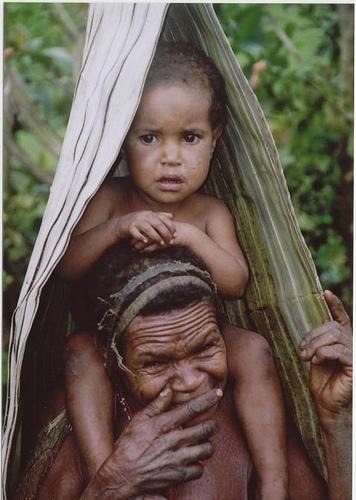Yali country
The Yalimo area of West Papua‘s Central Highlands remained isolated from the outside world even longer than the neighbouring Baliem Valley. The first missionaries made it here in 1961 but did not set up an outpost until 1968. There are still plenty of people who remember the days of cannibalism, inter-tribal warfare, the first white people coming down from the mountains and the murder of missionaries. The scenery is more spectacular than the Baliem Valley and the people more traditional, friendlier and less used to seeing outsiders.
Unlike the Baliem Valley, the Yalimo is not accessible by regular flights and there are no roads whatsoever. You get here either by a multi-day trek from the Baliem Valley or by chartering a missionary plane (see main Baliem Valley page for all details on both of these options – how to organise them, what trekking routes to take, etc).
While not actually part of the Yalimo, the people in the area around Moning, Ninia and Sobaham speak a Yali dialect and so I have included them in this section of the website. This is the first Yali area you will come to if trekking from the Baliem Valley to Angguruk (the Yalimo’s largest village) via the longer but easier route described in the Baliem Valley section of this website. After Sobaham there will be a 14-hour trek to Waniyok, one of the first villages of the Yalimo located three hours from Angguruk.
If taking the shorter, tougher route over Gunung Elit the first village you will come to will be Pronggoli.
A trek across the Yalimo from Angguruk – Helariki – Mimbaham – Telampela – Kosarek takes you through the Central Highlands’ most traditional area. More people here wear traditional (un)dress than anywhere else in the region, including young boys who wear extremely short kotekas (penis gourds), gradually replacing them with longer ones as they get older. If you are not going to do this trek, a good place to meet these people is Angguruk‘s market, as people from all over the area come to sell fruits and vegetables. However, even in small villages in this area not more than 10 – 20% of people wear traditional (un)dress.
The Angguruk – Kosarek trek can be done in one day by a young, fit Yali who walks very fast all day without stopping and knows the way well. It can also be done in a week by less healthy Westerners who want to take it more slowly, enjoying the incredible scenery and spending time in villages to meet locals.
From Kosarek, the last main settlement in the Yalimo, treks can be continued east into Mek Country, either to Nalca and Eipomek by a southern route or Nipsan by a northern route. Very few tourists visit this area but it has long been served by very irregular missionary flights from Wamena in the Baliem Valley and the people here are less traditional than in the Yalimo.
Although local languages are the mother tongue throughout Yali country, most people speak enough Indonesian to communicate. English speakers on the other hand are limited to one or two people in Angguruk.

Leave a Reply